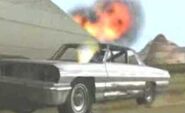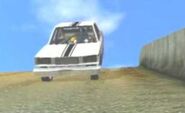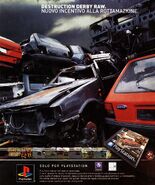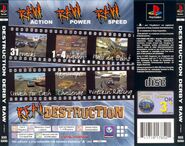| Line 72: | Line 72: | ||
Although points were always a key element in the series, Raw expanded on the points system with a much greater amount of point-earning events - the previous games were somewhat limited to spins. Each point 'event' also bears a unique name of its own that is displayed on screen when achieved. There has also been a change to the damage engine - in Raw, a car that has had its front badly smashed cannot be totally [[wrecked]] unless the overall damage meter is filled up. This arguably makes it less risky to hit others with the front bumper compared to DD2 and the first DD. Also, tyres are no longer lost by damage. |
Although points were always a key element in the series, Raw expanded on the points system with a much greater amount of point-earning events - the previous games were somewhat limited to spins. Each point 'event' also bears a unique name of its own that is displayed on screen when achieved. There has also been a change to the damage engine - in Raw, a car that has had its front badly smashed cannot be totally [[wrecked]] unless the overall damage meter is filled up. This arguably makes it less risky to hit others with the front bumper compared to DD2 and the first DD. Also, tyres are no longer lost by damage. |
||
| − | ''Destruction Derby Raw'' no longer uses a 'division' system in its career modes, and it has no seasons either (this was also the case in ''[[Destruction Derby 64]]''). Every race is instead done individually. Raw is also the only game in the series where career modes do not have any derby events, only races. |
+ | ''Destruction Derby Raw'' no longer uses a 'division' system in its career modes, and it has no seasons either (this was also the case in ''[[Destruction Derby 64]]''). Every race is instead done individually. Raw is also the only game in the series where career modes do not have any derby events, only races. In Raw, the player always starts a race on 20th (last) place. |
Like DD2 before it, Raw was very much American-inspired, but this time shed the high-speed [https://en.wikipedia.org/wiki/NASCAR NASCAR] style in favour of a western/country theme, with many cars based on American classics. This is very well demonstrated in the game's credits FMV, mixing both that theme with a [https://en.wikipedia.org/wiki/Silent_film silent film]-like presentation.<ref>{{cite web |url=https://www.youtube.com/watch?v=JPddFhNdjis |title=PlayStation - Destruction Derby Raw Credits (HD) |publisher=YouTube (uploaded by King Arthur Pendragon)}}</ref> |
Like DD2 before it, Raw was very much American-inspired, but this time shed the high-speed [https://en.wikipedia.org/wiki/NASCAR NASCAR] style in favour of a western/country theme, with many cars based on American classics. This is very well demonstrated in the game's credits FMV, mixing both that theme with a [https://en.wikipedia.org/wiki/Silent_film silent film]-like presentation.<ref>{{cite web |url=https://www.youtube.com/watch?v=JPddFhNdjis |title=PlayStation - Destruction Derby Raw Credits (HD) |publisher=YouTube (uploaded by King Arthur Pendragon)}}</ref> |
||
Revision as of 18:33, 31 August 2018
| Destruction Derby Raw | |
|---|---|
 
| |
| Developer | Studio 33 |
| Publisher | EU: Psygnosis NA: Midway Games |
| Original release | 2000 |
| Players | 1-4 players |
| Ratings | ELSPA: 3+ ESRB: E |
| Predecessor | Destruction Derby 2 (not counting Destruction Derby 64) |
| Successor | Destruction Derby Arenas |
Can anyone stop the mechanical mayhem?~ from the main menu theme
Destruction Derby Raw is the fourth installment in the Destruction Derby series, released exclusively for the PlayStation in June 2000. It was developed by Studio 33 and published by Psygnosis (in Europe) and by Midway Games (in North America).
Development
Reflections Interactive, the developers of Destruction Derby and Destruction Derby 2, started working on the hit action-driving game Driver in 1998 and ended its relationship with Destruction Derby.[1] Studio 33 earned the rights from Sony Computer Entertainment (SCE) for the franchise and started developing Destruction Derby 3 in 1999.
Psygnosis disappeared from North America by 1999, but through a publishing deal with Midway Games, Raw was able to be released on that market too.[2] The same year saw the release of Destruction Derby 64, developed under license from Psygnosis. Destruction Derby Raw was one of the last games to feature the Psygnosis name as the company was fully integrated into SCE Europe and renamed to Studio Liverpool.
The two PlayStation predecessors had platinum sales, and Raw continued this success yet again. It was added to PlayStation's Platinum Range/Greatest Hits on 15 February 2002. Raw never had a Japanese release.
Early images
These are screenshots taken from the PlayStation Magazine 01/00 disc from 1999, which show early previews of Destruction Derby 3.
DD3 beta images
Car images
These images show how the three cars in question looked like some time during development. They were taken from the Spanish Superjuegos magazine. They look similar to final except from minor design changes, like the colours and wheels.
Release dates
- PlayStation
- EU: 30 June 2000
- NA: 26 September 2000
Gameplay
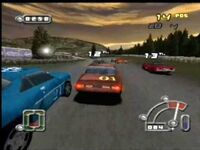
A race in Up 'n Over
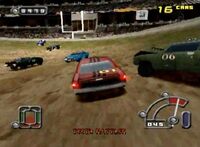
Classic mode played in Killing Field in a Supernova
Destruction Derby Raw had a large overhaul in gameplay terms. Physics and car handling were more realistic. The classic Destruction Derby events have also been toned down a bit compared to Destruction Derby 2, making them easier to complete (DD2 was considered by many to be very difficult).
The pit stops were removed in tracks as well as the commentator, and competitors' profiles. The commentator was re-added Raw's successor, Destruction Derby Arenas, making Raw the only game in the series without a commentator. A notable addition to Raw was the turbo boost, which gives temporary extra speed to the player.

The player in a Police car, in Oilslick
Although points were always a key element in the series, Raw expanded on the points system with a much greater amount of point-earning events - the previous games were somewhat limited to spins. Each point 'event' also bears a unique name of its own that is displayed on screen when achieved. There has also been a change to the damage engine - in Raw, a car that has had its front badly smashed cannot be totally wrecked unless the overall damage meter is filled up. This arguably makes it less risky to hit others with the front bumper compared to DD2 and the first DD. Also, tyres are no longer lost by damage.
Destruction Derby Raw no longer uses a 'division' system in its career modes, and it has no seasons either (this was also the case in Destruction Derby 64). Every race is instead done individually. Raw is also the only game in the series where career modes do not have any derby events, only races. In Raw, the player always starts a race on 20th (last) place.
Like DD2 before it, Raw was very much American-inspired, but this time shed the high-speed NASCAR style in favour of a western/country theme, with many cars based on American classics. This is very well demonstrated in the game's credits FMV, mixing both that theme with a silent film-like presentation.[3]
Points system

DDR's points indicator.

DDR's damage indicator.
Destruction Derby Raw named two different points that could be earned: Crash Points, which deals with wrecking; and Race Points, which are earned from race positions. The race points feature would award the player extra points, depending on their race position, similar to Wreckin' Racing in the original Destruction Derby game.
Race Points
- In Wreckin' Racing mode, the race position 1st gets 1000 race-points added together with the Crash points. 2nd gets 900, 3rd gets 800, 4th gets 700, 5th gets 600, 6th gets 500, 7th gets 400, 8th gets 300, 9th gets 200 and 10th gets 100 race points. Below 10th place gets no race points.
- In Smash 4 $ mode, all the total points you get in every event will be transferred into money ($).
Crash Points
All the crash points in the game have names, as shown in the game's manual. The manual also states: "The lowest single score is 10 points for a minor bump, but you can create combo carnage for up to 1000 points!". The maximum number of points possible is 9999, though this is extremely hard to reach and arguably only possible in the Classic or Skyscraper events. In the Battle modes, the points are referred as 'Battle Points' at the end of an event.
The tables below show all the points events in Destruction Derby Raw.
| Event | Name | Points |
| Minimal damage | TEETH RATTLER | 10 |
| Medium damage | JAW BREAKER | 30 |
| Massive damage | BONE CHRUNCHER | 50 |
| Barrier slammed | BARRIER SLAMMER | 50 |
| Roof hit | SKULL CRUSHER | 200 |
| Belly hit | GUT WRENCHER | 200 |
| Car destroyed | FLATLINER | 300 |
| Spins | Name | Points |
| 90° X axis | 90° LOOP | 50 |
| 180° X axis | 180° LOOP | 100 |
| 360° X axis | LOOP THE LOOP | 200 |
| 720° X axis | 2X LOOP THE LOOP | 300 |
| 90° Y axis | 90° SPIN | 50 |
| 180° Y axis | 180° SPIN | 100 |
| 360° Y axis | 360° SPIN | 200 |
| 720° Y axis | 720° SPIN | 300 |
| 90° Z axis | 90° ROLL | 50 |
| 180° Z axis | 180° ROLL | 100 |
| 360° Z axis | BARREL ROLL | 200 |
| 720° Z axis | 2X BARREL ROLL | 300 |
X axis = loops. Y axis = spins. Z axis = rolls.
| Combos | Name | Points |
| Spin + Spin | HURRICANE | 400 |
| Roll + Roll | TIDAL WAVE | 400 |
| Loop + Spin | ROLLERCOASTER | 500 |
| Spin + Roll | CORKSCREW | 500 |
| Roll + Loop | REVOLVER | 500 |
| Skull Crusher + Flatliner | HITMAN SPECIAL | 700 |
| Gut Wrencher + Flatliner | VULTURE FEAST | 700 |
| Spin + Spin + Flatliner | A-BOMB | 900 |
| Roll + Roll + Flatliner | AIRLINE CRASH | 900 |
| Loop + Spin + Flatliner | UNDERTAKER | 1000 |
| Spin + Roll + Flatliner | ANGEL OF DEATH | 1000 |
| Roll + Loop + Flatliner | GRIM REAPER | 1000 |
Game modes

Destruction Derby Raw Main Menu
Destruction Derby Raw has a large variety of game modes with several newly introduced, including a team-play mode and a DD-style event on top of buildings. The Battle modes all support multiplayer with up to 4 player splitscreen.
- Wreckin' Racing
- Smash 4 $
- Battle
- Assault
- Destruction Derby
- Skyscraper
- Pass Da Bomb
Locations
Tracks

Wreckin' Racing screen with all tracks unlocked
Destruction Derby Raw has a total of 25 race tracks (most in the series). For some tracks there are two variants: one being a long one and the other a short one. In the case of Avalanche though, both its two variant tracks are about the same in length but with subtle differences - for the sake of correctness it is labelled here as [1] and [2] instead.
However the short version of a track is not necessarily quicker lasting - their laps are normally higher, and the number of laps can range from 4 to as much as 15 (in Oilslick and Carpark).
The following list of tracks is sorted by their order of appearance in Smash 4 $:
*Has 15 competitors rather than 19, presumably due to the short size of these tracks.
Bowls
There are three bowls (each called "Arena" in-game) with the main differences being the environment. Unlike Destruction Derby 2, all the bowls in Raw are available from the beginning without having to unlock them.
Highrises
The skyscrapers (called "Highrise" in-game) are the top of blocks used in Skyscraper mode.
Vehicles

The 8 bonus cars
There are 18 cars in the game. Each of the cars have an upgraded version, effectively making 36 total. The upgraded models usually have better stats, and are distinguished by their wheels. Many of the cars are based on classic American ones.
Bonus cars are basically part of the total 36, but are treated as ones that must be unlocked one by one in Wreckin' Racing, before they can be bought (and saved) in Smash 4 $ mode.
Cars can be saved on the PlayStation memory card so that they can be loaded and used in one of the Battle modes. To do this, the player must first purchase a car in Smash 4 $ before having the ability to save it. Any owned car from Smash 4 $ can be saved with those stats, so if the car has been tuned (upgraded), it would be saved that exact way. This also includes if the car's Strength stat has decreased after taking part in a Smash 4 $ race.
Cars listed italic are bonus cars..
* Not driven by your competitors.
Unplayable
These cars appear in-game (whether in gameplay or an FMV) although are not playable.[4]
Competitors
Unlike the two predecessors, the competitors in Raw don't have a profile or picture. However they do still differ in terms of ability.
- EatMyDust (#05)
- U Suck (#06)
- The Beast (#07)
- Wet 'n Wild (#08)
- V8 or Bust (#09)
- Hot Balls (#10)
- Huggybear (#11)
- Wide Load (#12)
- Un Hinged (#13)
- Road Kill (#19)
- Steelmutha (#20)
- Berserkoid (#21)
- Speedfreak (#22)
- GT Luvva (#23)
- Burnout (#24)
- Easy Ride (#25)
- Fastback (#26)
- Harry (#33)
- Punk Face (#69)
The best competitors in races are Punk Face, Harry, Fastback and Easy Ride. They normally always begin races from 1st to 4th place respectively, and usually always finish in the top 6. These four notably also have unique exclusive paintjobs that cannot be chosen by the player. These four don't take part in derby events.
Each competitor has two or three types of cars of choice that they use, and two colour choices. Their choice always depends on what car and colour the player chooses.
High Score names
When you newly start the game, the default high scores are as follows:
| WRECKIN' RACING | SMASH 4 $ | ASSAULT | CLASSIC DD | PASS DA BOMB | SKYSCRAPER |
| MAGICAL M | RICHIE | NEWY | DOMINATOR | GREASY LVR | AL SPARROW |
| TAZ | JEZ | MUMBLES | TECHNIK | HARRY | JEZ |
| LOVEHANDLE | BISHI | WAGGY | DAZZLER | PUNKFACE | RICHIE |
These all look like random names, with the exception of HARRY and PUNKFACE, which are real competitors in the game.
Soundtrack
The game's soundtrack is made up of rock, with a few other influences including country music. According to the credits, as listed under In-game Music ~ Psygnosis, Gary McKill, Mike Clarke, and Dan Selby composed the songs. Interestingly if you put the Raw CD in a computer, the OS would tag the artist as System of a Down. This is most likely just a tongue-in-cheek by a Psygnosis employee.
Unlike the previous games, Raw does not have an in-game music player. However the disc is still CDDA so the tracks can be played on a standard CD player.
The title of the first song, "Overwhelm and Destroy", originates from the 1966 American film Mondo Keyhole. This also appeared in the song "Brain Freeze" in Command & Conquer: Yuri's Revenge.
| Track no. | Name | Featured in | Length | Link to YouTube |
| #1 | Overwhelm and Destroy | Dragonfly, Overflow, Slammer, Main Menu | 4:20 | [1] |
| #2 | Overdrive | Jagged Edge, Loops of Fury | 3:13 | [2] |
| #3 | Adrenaline Rush | Overflow, Stadium | 3:25 | [3] |
| #4 | Want Some Fast | Sidewinder, Jagged Edge, Four, Vertigo | 3:11 | [4] |
| #5 | Low Ride | Karsutra, Carpark, Dragonfly, Killing Field | 3:01 | [5] |
| #6 | Careening | Up 'n Over, Loops of Fury, Axehead, Docklands | 3:38 | [6] |
| #7 | Do What You Want To Do | Fall Out, The Wreckoning, Intro | 4:15 | [7] |
| #8 | Country Crush | Oilslick, Fall Out, Cyclone, Credits | 3:13 | [8] |
| #9 | Screaming Siren | Axehead, Up 'n Over, Loops of Fury, Docklands | 3:26 | [9] |
| #10 | Pounding Pavement | Avalanche, High Pressure | 3:01 | [10] |
Intro

RawIntro
Regional differences

Difference between points' font: original PAL (top) and NTSC (bottom)
Destruction Derby Raw is the only game in the Destruction Derby series that contain (at least notable) regional differences. As the game was published in North America by Midway Games instead, a different cover box art was created and the logo on the cover was redesigned too. In-game however this logo never appears and the original PAL European one is still there.
The most notable change in-game is the font used for when earning points. Whilst the European release uses the flaming-coloured font like from the 'RAW' typeface, the NTSC American version has a different one. Weirdly, the typeface in the main menus are still the same, and not like the one used for points.
In the American version the turbo boost meter is coloured green rather than blue. At the start of a race when the lights turn green, you can drive off almost immediately whereas in the European release there is a split second delay (although this might actually be caused by the 50/60hz difference). Also if the player is positioned 1st in a race, or there is only 1 lap left, the number indicator turns to red and flashes. The colours remain just yellow and static in the European release.
Two other subtle differences that may be considered mistakes in the American version is that on startup it still contains the PRESS START screen despite there being no choice of other languages. Also when crossing the finishing line in a race, the number of laps spins back to 1, rather than turning to 0.
Reception
| Reviewer | Score |
| GameSpot | 7.5 out of 10[5] |
| IGN | 7.9 out of 10[6] |
| GameFan | 50%[7] |
| NextGen | 2 out of 5[8] |
| Playmania (ES) | 7 out of 10[9] |
| Official PlayStation Magazine (NZ) | 8 out of 10[10] |
| Superjuegos (ES) | 86%[11] |
Reception to Destruction Derby Raw was largely mixed to positive. PlayStation Magazine (PSM) in a preview called the Pass Da Bomb mode a "great addition" and was happy with the "realistic" car damage.[12] The reviewer from GamePro called it a "good" game and praised the sound effects and its "appropriate" soundtrack, but noted the "significant slowdown" when a lot of cars are on screen.[13] Chet Barber from NextGen felt that DDR brought nothing new to the table compared to the first two games, and thought that there was a quality decrease.[8]
Advertisement
Box arts
Front covers
Back covers
References
- ↑ Full text of "Arcade - Issue 02 (1999-01)(Future Publishing)(GB)". Future Publishing (January 1999).
- ↑ Destruction Derby Raw Review. GameSpot (27 Sep 2000).
- ↑ PlayStation - Destruction Derby Raw Credits (HD). YouTube (uploaded by King Arthur Pendragon).
- ↑ Source: Internet Game Cars Database, http://www.igcd.net/
- ↑ Error on call to Template:cite web: Parameters url and title must be specifiedFrank Provo (27 September 2000). . GameSpot.
- ↑ Error on call to Template:cite web: Parameters url and title must be specifiedDoug Perry (5 October 2000). . IGN.
- ↑ GameFan (Vol 8 Issue 10): 54.
- ↑ 8.0 8.1 Chet Barber (November 2000). NextGen (Vol 2 Issue 11).
- ↑ Playmania (38): 078.
- ↑ Official NZ PlayStation Magazine (041): 77. January 2001.
- ↑ Superjuegos (099): 86.
- ↑ PlayStation Magazine (37): 34. September 2000.
- ↑ Review: Destruction Derby Raw (from GamePro.com). CNN/GamePro (19 October 2000).
Credits
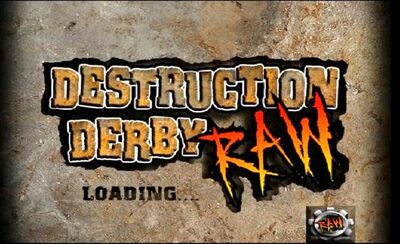
The loading screen
- Lead Programmer
- Nick Koufou
- AI Programmer
- Martin MacGill
- Dynamics Programmer
- Tom Shepherd
- Sound Programmer
- Tasos Brakis
- Sound Designer
- Tasos Brakis
- Front‑End
- Shaun Morris, Rich Yandle
- Tools
- Luke Boumphrey, Ron Culton
- Additional Programming
- Chris Carty, Phil Hilliard, John White
- Track Artists
- Dominic Giles, Nick Hinton, Jeremy Ramsay
- Texture Artists
- Darrell Gallagher, Ian Hall
- Cars
- David Glanister
- FMV Artists
- John Carter, David Newhouse
- Graphic Designer
- Lee Wagner
- Web Design
- Sandra Connor
- Managing Director
- John White
- Special Thanks
- Beverley Bright, Paul Houlders



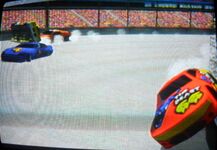



![RawbetaS4$.jpg (74 KB) Notice the name [DRAGONFLY - SHORT], and the art of the track.](https://static.wikia.nocookie.net/destructionderby/images/3/31/RawbetaS4%24.jpg/revision/latest/scale-to-width-down/185?cb=20120513203232)

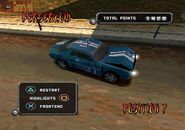

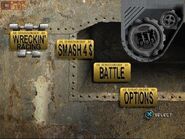


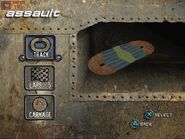



![Dragonfly1b.png (214 KB) Dragonfly [Short]](https://static.wikia.nocookie.net/destructionderby/images/f/f9/Dragonfly1b.png/revision/latest/scale-to-width-down/93?cb=20180823233049)

![Fallout1b.png (239 KB) Fall Out [Short]](https://static.wikia.nocookie.net/destructionderby/images/1/17/Fallout1b.png/revision/latest/scale-to-width-down/92?cb=20180823233051)

![Avalanche1b.png (235 KB) Avalanche [1]](https://static.wikia.nocookie.net/destructionderby/images/c/c0/Avalanche1b.png/revision/latest/scale-to-width-down/96?cb=20180823233045)
![Axehead1b.png (230 KB) Axehead [Short]](https://static.wikia.nocookie.net/destructionderby/images/9/9f/Axehead1b.png/revision/latest/scale-to-width-down/95?cb=20180823233046)
![Overflow1b.png (253 KB) Overflow [Long]](https://static.wikia.nocookie.net/destructionderby/images/3/3e/Overflow1b.png/revision/latest/scale-to-width-down/90?cb=20180823233056)

![UNO1b.png (263 KB) Up 'n Over [Long]](https://static.wikia.nocookie.net/destructionderby/images/d/d6/UNO1b.png/revision/latest/scale-to-width-down/90?cb=20180823233446)
![Overflow2b.png (255 KB) Overflow [Short]](https://static.wikia.nocookie.net/destructionderby/images/4/4d/Overflow2b.png/revision/latest/scale-to-width-down/90?cb=20180823233056)
![Fallout2b.png (232 KB) Fall Out [Long]](https://static.wikia.nocookie.net/destructionderby/images/c/c8/Fallout2b.png/revision/latest/scale-to-width-down/98?cb=20180823233052)
![LOF1b.png (227 KB) Loops of Fury [Long]](https://static.wikia.nocookie.net/destructionderby/images/a/a4/LOF1b.png/revision/latest/scale-to-width-down/100?cb=20180823233054)
![JE1b.png (236 KB) Jagged Edge [Long]](https://static.wikia.nocookie.net/destructionderby/images/c/c3/JE1b.png/revision/latest/scale-to-width-down/95?cb=20180823233053)
![UNO2b.png (254 KB) Up 'n Over [Short]](https://static.wikia.nocookie.net/destructionderby/images/c/cf/UNO2b.png/revision/latest/scale-to-width-down/91?cb=20180823233447)
![JE2b.png (237 KB) Jagged Edge [Short]](https://static.wikia.nocookie.net/destructionderby/images/a/aa/JE2b.png/revision/latest/scale-to-width-down/96?cb=20180823233053)
![Avalanche2b.png (230 KB) Avalanche [2]](https://static.wikia.nocookie.net/destructionderby/images/f/ff/Avalanche2b.png/revision/latest/scale-to-width-down/96?cb=20180823233045)

![Dragonfly2b.png (249 KB) Dragonfly [Long]](https://static.wikia.nocookie.net/destructionderby/images/7/76/Dragonfly2b.png/revision/latest/scale-to-width-down/91?cb=20180823233050)
![Axehead2b.png (249 KB) Axehead [Long]](https://static.wikia.nocookie.net/destructionderby/images/c/c8/Axehead2b.png/revision/latest/scale-to-width-down/93?cb=20180823233046)

![LOF2b.png (241 KB) Loops of Fury [Short]](https://static.wikia.nocookie.net/destructionderby/images/1/14/LOF2b.png/revision/latest/scale-to-width-down/96?cb=20180823233055)





